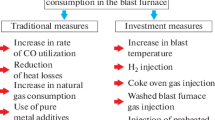Abstract
The energy effects accompanying the processing of the feed material to a lead blast furnace are considered in terms of a reversible model. Relative to this model the efficiencies of operating furnaces are found to be in the range 18 to 35 pct. The effects of the effluent gas CO2/CO ratio and temperature and oxygen enrichment of the blast air in the thermodynamic efficiency are quantified. Improvements in efficiency achieved in industrial furnaces as a result of oxygen enrichment of the blast air are substantially greater than those predicted. Mass and enthalpy balances on an industrial lead blast furnace are presented from which it is estimated that approximately 9 pct of the carbon charged to the furnace is lost due to the solution loss reaction in the upper regions of the furnace.
Similar content being viewed by others
References
J. T. Chao, P. J. Dugdale, D. R. Morris, and F. R. Steward:Met. Trans. B, 1978, vol. 9B, pp. 293–300.
H. W. Meyer, H. F. Ramstand, and W. H. Goodnow:Blast Furnace Theory and Practice, J. H. Strassburger, ed., chapt. XV, Gordon and Breach, New York, 1969.
V. Koump: Unpublished research, U.S. Steel Co., Monroeville, PA, 1961, see chapt. XIX of Ref. 2.
O. Kubaschewski, E. L. Evans, and C. B. Alcock,Metallurgical Thermochemistry, Pergamon Press, Oxford, U.K., 1967.
I. Barin, O. Knacke, and O. Kubaschewski:Thermochemical Properties of Inorganic Substances andSupplement, Springer-Verlag, Berlin, 1973 and 1977.
R. Hultgren, P. D. Desai, D. T. Hawkins, M. Gleiser, and K. K. Kelley:Selected Values of the Thermodynamic Properties of Binary Alloys, ASM, Metals Park, OH, 1973.
J. F. Elliott, M. Gleiser, and V. Ramakrishna:Thermochemistry for Steel-making, vol. II, Addison-Wesley Publishing Co., Reading, MA, 1963.
AIME World Symposium on Mining and Metallurgy of Lead and Zinc, C. H.Cotterill and J. M. Cigan, eds., vol. II, sections VI 24, VI 25, and VI 29, AIME, NY, 1970.
G. W. Toop: Private communication, Cominco Ltd., Trail, British Columbia, Canada, 1979.
H. Ceckler, H. N. Lander, and J. M. Uys: chapt. XVI, Ref. 2.
J. L. Leroy, P. J. Lenoir, and L. E. Escoyez: section VI 28, Ref. 8.
J. E. Cowperthwaite, C. J. F. Landry, and T. C. Wilson: Practice School Report, Department of Chemical Engineering, University of New Brunswick, Fredericton, New Brunswick, Canada, 1978.
P. J. Dugdale and A. Young: Unpublished research, Brunswick Mining and Smelting Co., New Brunswick, Canada, 1975.
J. T. Chao: M. Eng. Thesis, Dept. of Chemical Engineering, University of New Brunswick, Fredericton, New Brunswick, Canada, 1977.
R. Schuhmann:Metallurgical Engineering, Engineering Principles, vol. 1, Addison Wesley, Reading, MA, 1952.
A. E. Morris and J. R. Knoepke:Met. Trans. B, in press.
Author information
Authors and Affiliations
Additional information
David R.Morris, currently on sabbatical leave, University of Cambridge, Cambridge, United Kingdom.
Rights and permissions
About this article
Cite this article
Cowperthwaite, J.E., Dugdale, P.J., Landry, C.J.F. et al. Energy aspects of a lead blast furnace. Metall Trans B 11, 291–299 (1980). https://doi.org/10.1007/BF02668414
Received:
Issue Date:
DOI: https://doi.org/10.1007/BF02668414




